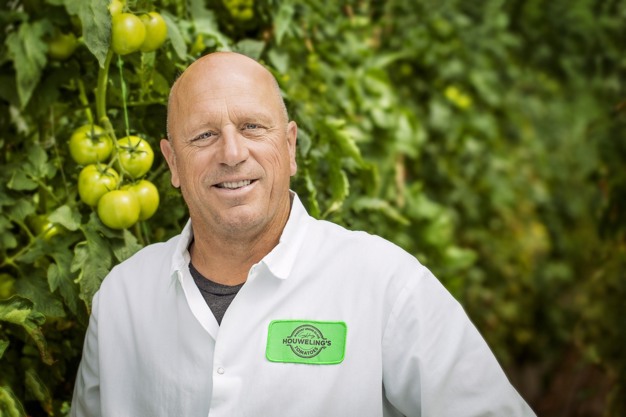Would the Ultra-Clima greenhouse ever have been developed if a tomato grower in California hadn't had a whitefly infestation? Presumably. Although it certainly helped that this grower wasn't just anyone but was Casey Houweling. The responsible greenhouse constructor also wasn't just any company either. Together with KUBO, the American grower with 'Dutch roots' was at the forefront of the biggest innovation in greenhouse construction. "If it's going to be 34 degrees today with 5% humidity, we can handle that easily."
"We'd been having a lot of problems with whitefly," Casey began his story. "This also brought a virus with it: the ToCV virus. I went to Spain to see how they handled problems like this there. Those growers used insect screens, and we immediately purchased 20,000. As the supplier didn't have that capacity, they outsourced production to an Italian manufacturer. Six months later, all those screens fell down because they weren't UV-proof!"
Looking back, that's when the Ultra-Clima greenhouse evolution started, stated Casey. He is the former owner of Houweling's Tomatoes, which grows 90 hectares of tomatoes in California and Canada, a third of these being grown in Ultra-Clima greenhouses. "Those insect screens reduced cooling capacity, you lost light, and you got a shitty climate." They had the idea of creating overpressure in the greenhouse to try to keep the insects out. "We started small-scale experiments in a section of the greenhouse using hoses and a cooling pad. KUBO developed a concept together with Enerdes, a Dutch greenhouse climate system supplier. After a year-and-a-half, we'd developed the first 16-hectare Ultra-Clima greenhouse with KUBO. Yes, 16 hectares. We had the idea that we'd already learned enough."
Modifications
The revolutionary greenhouse concept appeared to work, although some modifications were required. Casey continued: "We started with one hose in the greenhouse. Where the fan starts, you have an airflow of 100%, but at the end of the hose, the airflow fell to zero as the hose had to make a 90-degree angle. So, the crops grew under different temperatures. We used a smoke machine to test how the air moved through the greenhouse." The solution was simple: a second hose was used over a distance of 125 meters. "That was fifteen years ago and was actually just the start of the success story. You now find Ultra-Clima greenhouses across the world. We immediately patented the concept but have since learned that a patent is difficult to protect. There are always copycats."

Doubts about use in other parts of the world
Although the greenhouse proved its worth in the Californian climate, global success wasn't something they'd really factored in. "At the beginning, I had doubts about whether it would work in other parts of the world. But the more I learned, the more I started believing in it. You have a huge wealth of options, so you can now grow vegetables much more cheaply, even in deserts or extremely dry climates. You can grow in areas where water is difficult to access."
Different way of cultivating
The new greenhouse also results in a different way of cultivating. When did he and his cultivation staff master that method? "You need to learn about all the options an Ultra-Clima greenhouse has, and you need to introduce a different cultivation style. I sometimes use the example of a car. It's easy for a driver to achieve top speeds in a Volkswagen. But in a Maserati, you need to be a really good driver. I think it easily took us some five years before we'd mastered the process and entered all the changes in the climate computer. And now a grower just says: oh if it's going to be 34 degrees today with 5% humidity we can handle that easily. The only thing that's still difficult is high humidity in a tropical climate."
Game changer
As 'founding father,' he's convinced that the Ultra-Clima greenhouse is a real game changer. "In an overpressured greenhouse, the greenhouse cover stays cleaner, you need 95% fewer vents, and the greenhouse can cope with lower CO2 levels." Changes were introduced over the years, though. "These weren't major changes as it's still the same greenhouse, but KUBO did modify the production method to improve production efficiency, energy efficiency was also increased, and carbon emissions were reduced. But we still have a long way to go. There are many more options to consider than just climate, including autonomous cultivation, maintenance, and labor management innovations. Robots are also being developed as people keep wanting to reduce their working hours."
Friendship with KUBO
Would the Ultra-Clima greenhouse ever have seen the light of day if Casey hadn't contacted KUBO? Casey shook his head. "From day one, KUBO believed in the idea. They supported us and developed the concept with us. This working relationship ultimately blossomed into a friendship. We'd already had a relationship with KUBO for decades, and I knew Wouter's grandfather. That made it easier to take this step together. KUBO is a true strategic partner for Houweling Tomatoes. You need to have trust in each other."
And that trust goes even further than just constructing their own greenhouses. "I'm so proud of the Seeds of Tomorrow project: a propagation greenhouse that we built together in Guatemala in an area of extremely high poverty."
For more information:
KUBO Group
Vlotlaan 710
2681 TX, Monster
Tel.: +31 (0)174 286 161
info@kubo.nl
www.kubogroup.nl
